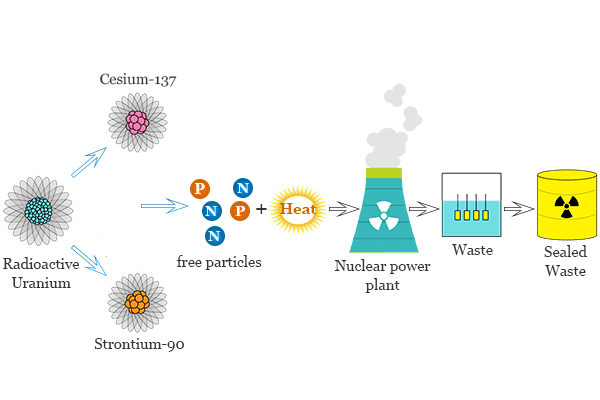Radioactive Pollution Sources
Radioactive pollution is the nuclear radiation of alpha beta gamma particles from radioactive substances during the nuclear reactions which affect our environment. Simply radioactive pollution is defined as the increase of radioactive radiation caused by different types of human activities. Radioactive liquid or gaseous wastes released during nuclear explosions, radioactive decay in the nuclear power generation process, and radiation used in medicine and different types of research are the main sources of radioactive pollution. Radioactive waste has some level of radiation. We cannot dispose of radioactive waste in the same way as normal waste. For solutions to radioactive pollution, select proper techniques to reduce the volume and toxicity of nuclear wastes.

Effects of Radioactive Pollution
Different types of radioactive elements and nuclear tests effects our environment to cause different types of pollution. These materials are dangerous for human health or animals.
- For example, radioactive elements like strontium-90 effects mainly our soil. It also negatively affects human beings and animals.
- Nuclear tests that are operated in the sea make seawater polluted which affects aquatic life.
Radioactive Waste Disposal
Low-level radioactive liquid wastes, radioactive gaseous wastes, and dust are released during nuclear explosions. The radioactive gaseous wastes are injected into the upper layer of the atmosphere.
Due to cooling, they are condensed into fine dust particles and a radioactive cloud is formed. This cloud moves in the direction of the wind and settles down slowly to the surface of the earth. Therefore, it causes air pollution or water pollution.
Gamma-ray Emission
Among the radioactive emissions, gamma rays are the most dangerous. Since they have high energy and high penetrating power. Therefore, these radiations pass freely to the human body where they lose energy. It destroyed the living cells by converting them into charged particles.
These charged particles are chemically very active and they disrupt the cell membranes, reducing the effectiveness of enzymes. All these are causes the diseases like leukemia and cancer.
Harmful Effects of Nuclear Energy

We know that in a nuclear reactor, U-235 is used as a nuclear fuel. U-235 undergoes nuclear fission to produce energy. The process of mining and enrichment of U-235 produces nuclear radiation. When these radiations leak from the nuclear reactor, it damage the health of human beings and animals.
Solutions to Radioactive Pollution
The pollution caused by the radioactive waste can be controlled in the following ways,
- The waste materials produced in the mining, enrichment, and fission of U-235 inside the reactor are collectively called nuclear wastes. For solutions to nuclear pollution, select the proper reagents and procedures that minimize the volume and toxicity of radioactive wastes.
- At present, most of the nuclear wastes are being stored in strong leak-proof containers. It is deep inside the hard rock formations. A great vigilance should be kept on the stored radioactive materials or waste products to prevent leakage of any radioactive materials during storage and disposal.
- Non-radioactive elements are never mixed with radioactive materials to increase the pollution level of radioactive wastes.








